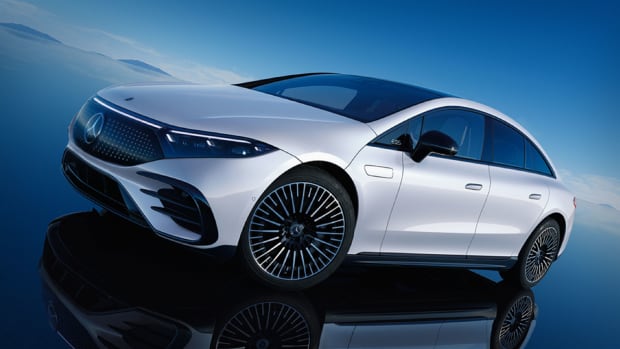
Tesla (TSLA) might be the loudest in the room when talking about driverless cars, but Mercedes (DDAIF) claims it just beat Tesla at its own game.
The German sports car manufacturer released its EQS electric model in Germany in 2021, then later in the United States. With a starting price at $105,450, it was ranked eighth for luxury electric vehicles (EVs) by Car and Driver, behind Lucid's Air, several of the Porsches, the Tesla model S and the BMW i7.
"It spoils its riders with voluminous interior space, gorgeous cabin materials, headrest pillows, massage functions, and neck-and-shoulder heating. However, if you want your vehicle to be a car first and a living room second you'll be disappointed," Car and Driver writes of the EQS, adding it "needs a lot more refinement to reach," the top of the EV class.

Mercedes-Benz
Mercedes Makes Up Lost Ground
While folks fawn over the Cybertruck and the latest new EV, Mercedes has been hard at work developing the inside of its cars -- specifically, its autonomous driving capabilities. It claims its model year 2024 S-Class and EQS sedan models, which have Level 3 autonomy-capable software, are now cleared for use in Nevada up to 40 mph -- a big step for its U.S. market.
"Mercedes-Benz is the world's first automotive company to bring SAE Level 3 conditionally automated driving to the U.S., with Nevada being the first state to confirm the compliance of the system with state regulations," a company press release reads.
"This significant milestone sets the ground-breaking Mercedes-Benz DRIVE PILOT system apart as the first and only SAE Level 3 system in a standard-production vehicle authorized for use on U.S. public freeways. Complying with the requirements of Nevada Chapter 482A for Autonomous Vehicles, DRIVE PILOT will allow the driver to hand over the dynamic driving task to the vehicle under certain conditions."
Mercedes added it hopes California will be the next state to clear the way. Customers can get the compliant cars in the second half of 2023.
What Is Level 3 Autonomy?
Level 3 autonomy is the next natural step toward completely driverless vehicles in the future. It's known as "conditional automation," according to Torc.Ai, which means it has environmentally aware sensors to enable a car to drive itself, but a driver is still behind the wheel to take over during certain situations.
"In proper circumstances, the ADS (Automated Driving System) completes the entire dynamic driving task and then disengages quickly upon the driver’s command," Torc.Ai explains. "The driver is no longer obliged to constantly monitor the system or perform non-driving-related tasks while operating the vehicle. If the system prompts the driver, the driver must answer within a certain amount of time to avoid the system from disabling itself."
There are five levels of automation, ranging from zero (manual driving) to five (fully automated driving, where a rider might read a book while her car takes her where she needs to go).
Currently, Tesla has only achieved Level 2 with the help of its Autopilot driver assistance software. Anyone who's driven a Tesla might be familiar with its capabilities: the car might stay within a lane, assist with lane changes, and accelerate or decelerate depending on traffic conditions.
Tesla CEO Elon Musk has said he anticipated fully autonomous Teslas sometime this year.
"I would be shocked if we do not achieve full-self-driving safer than a human this year. I would be shocked," Musk told shareholders on an earnings call in July 2022.
Though he's been saying that since 2014.







